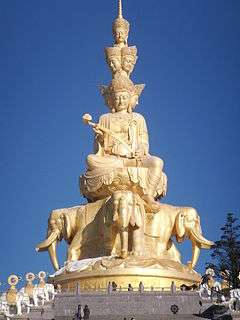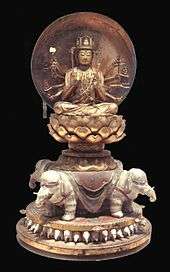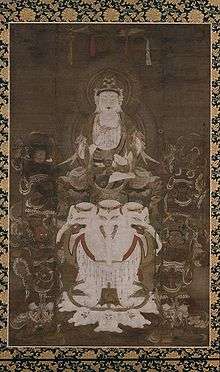Samantabhadra
Samantabhadra (Sanskrit: समन्तभद्र; lit. "Universal Worthy") is a bodhisattva in Mahayana Buddhism associated with practice and meditation. Together with Gautama Buddha and the bodhisattva Mañjuśrī, he forms the Shakyamuni Triad in Buddhism. He is the patron of the Lotus Sutra and, according to the Avatamsaka Sutra, made the ten great vows which are the basis of a bodhisattva. In Chinese Buddhism, Samantabhadra is known as Pǔxián and is associated with action, whereas Mañjuśrī is associated with prajñā (transcendent wisdom). In Japan, this bodhisattva is known as Fugen, and is often venerated in Tendai and Shingon Buddhism, and as the protector of the Lotus Sutra by Nichiren Buddhism. In the Nyingma school of Tibetan Buddhism, Samantabhadra is also the name of the Adi-Buddha – in indivisible Yab-Yum with his consort, Samantabhadrī.
| Samantabhadra | |
|---|---|
 | |
| Sanskrit | समन्तभद्र
Samantabhadra |
| Chinese | 普賢菩薩 普贤菩萨
(Pinyin: Pǔxián Púsà) |
| Japanese | (romaji: Fugen Bosatsu) |
| Khmer | សមន្តភទ្រ (sa-mun-ta-phoat) |
| Korean | 보현보살
(RR: Bohyeon Bosal) |
| Mongolian | үндэсамбуу Самандабадраа Хамгаар Сайн |
| Thai | พระสมันตภัทรโพธิสัตว์ |
| Tibetan | ཀུན་ཏུ་བཟང་པོ་ Wylie: kun tu bzang po THL: küntuzangpo |
| Vietnamese | Phổ Hiền Bồ Tát (Hán Nôm: 普賢菩薩) |
| Information | |
| Venerated by | Mahāyāna, Vajrayāna |
Origins
In the Lotus Sūtra, Samantabhadra is described at length in the epilogue, called the Samantabhadra Meditation Sutra (Chinese: 觀普賢菩薩行法經; pinyin: Guān Pǔxián Púsà Xíngfǎ Jīng), with special detail given to visualization of the bodhisattva, and the virtues of devotion to him.[1]
Samantabhadra is also a key figure in the Āvataṃsaka-sūtra, particularly the last chapter, the Gaṇḍavyūha-sūtra. In the climax of the Gaṇḍavyūha-sūtra, the student Sudhana meets Samantabhadra Bodhisattva, who teaches him that wisdom only exists for the sake of putting it into practice; that it is only good insofar as it benefits all living beings.
In the Āvataṃsaka-sūtra, the Buddha states that Samantabhadra Bodhisattva made ten great vows in his path to full Buddhahood:
- To pay homage and respect to all Buddhas.
- To praise the Thus Come One-Tathagata.[2]
- To make abundant offerings. (e.g. give generously)
- To repent misdeeds and evil karmas.
- To rejoice in others' merits and virtues.
- To request the Buddhas to continue teaching.
- To request the Buddhas to remain in the world.
- To follow the teachings of the Buddhas at all times.
- To accommodate and benefit all living beings.
- To transfer all merits and virtues to benefit all beings.
The ten vows have become a common practice in East Asian Buddhism, particularly the tenth vow, with many Buddhists traditionally dedicating their merit and good works to all beings during Buddhist liturgies.
Iconography
In Mahayana Buddhism

Unlike his more popular counterpart Mañjuśrī, Samantabhadra is only rarely depicted alone and is usually found in a trinity on the right side of Shakyamuni, mounted on a white elephant. In those traditions that accept the Avatamsaka Sutra as its root instruction, Samantabhadra and Manjusri flank Vairocana Buddha, the central Buddha of this particular sutra.
Known as Pǔxián in Chinese, he is sometimes shown in Chinese art with feminine characteristics, riding an elephant with six pairs of tusks while carrying a lotus leaf 'parasol' (Sanskrit: chatra), bearing similar dress and features to some feminine depictions of Guanyin. It is in this guise that Samantabhadra is revered as the patron bodhisattva of the monasteries associated with Mount Emei in western China. Some believe that the white elephant mount of Samantabhadra was the same elephant that appeared to Queen Maya, the mother of the Buddha, to herald his birth.
Mahayana esoteric traditions treat Samantabhada as one of the 'Primordial' (Sanskrit: Dharmakaya) Buddhas, but the main primordial Buddha is considered to be Vairocana.
In Esoteric Buddhism

It is very common for the bodhisattva of the Mahayana tradition with the name of Samantabhadra to be conflated with a Buddha with the same name that appears as the primordial Buddha in some of the Tibetan traditions, particularly the Nyingma. It is not the case that the Mahayana bodhisattva evolved or transformed in the course of assimilation into the esoteric Tibetan traditions, because in the latter both the Bodhisattva Samantabhadra and the Dharmakaya Samantabhadra are present as two separate and distinct entities.
In the tradition of the Nyingma school of Tibetan Buddhism, Dharmakaya Samantabhadra (not the bodhisattva of the Mahayana) is considered the most primordial Buddha, akin in status to Vajradhara for the Sarma traditions. Samantabhadra appears in the Vajrayana tantric text the Kunjed Gyalpo Tantra, as the Primordial Buddha, the 'embodiment' (Sanskrit: kaya) or 'field' (Sanskrit: kṣetra) of 'timeless awareness, gnosis' (Sanskrit: jñāna) awakened since before the very beginning. Therefore, in Tibetan Buddhism the Nyingma, or 'Old Translation' school, the Sakya and the Bön schools view Samantabhadra as the Primordial Buddha. In the Nyingma school of Tibetan Buddhist Vajrayana, Samantabhadra is considered a primordial Buddha in indivisible yab-yum union with his consort Samantabhadri. However, the Kagyu and Gelug schools use Vajradhara to represent the Primordial Buddha.
Dzongsar Khyentse Rinpoche following the Nyingmapa Dzogchen tradition qualifies the nature and essence of Samantabhadra, the Primordial Buddha, as the origin-less wellspring of the timeless and unbounded Atiyoga teachings, and honours the converse view entertained by some interested parties which hold that the Dzogchen teachings originated with either the Bonpo tradition or the Chinese monk Moheyan:
Samantabhadra is not subject to limits of time, place, or physical conditions. Samantabhadra is not a colored being with two eyes, etc. Samantabhadra is the unity of awareness and emptiness, the unity of appearances and emptiness, the nature of mind, natural clarity with unceasing compassion - that is Samantabhadra from the very beginning.[3]
'The Mirror of the Mind of Samantabhadra' (Tibetan: ཀུན་ཏུ་བཟང་པོ་ཐུགས་ཀྱི་མེ་ལོང, Wylie: kun tu bzang po thugs kyi me long ) is one of the Seventeen Tantras of Dzogchen Upadesha.[4]
In Sri Lanka
Sri Lankan people venerate Samantabhadra Bodhisattva as Saman (also called Sumana, Samantha, Sumana Saman, Sinhalese: සුමන සමන් දෙවි). The name Saman means "the rising morning sun". The god Saman is considered to be one of the guardian deities of the island as well as a protector of Buddhism. His main shrine is located in Ratnapura, where there is an annual festival held in his honor.[5]
Notes
- Katō Bunno, Tamura Yoshirō, Miyasaka Kōjirō, tr. (1975), The Threefold Lotus Sutra : The Sutra of Innumerable Meanings; The Sutra of the Lotus Flower of the Wonderful Law; The Sutra of Meditation on the Bodhisattva Universal Virtue. New York & Tōkyō: Weatherhill & Kōsei Publishing.
- THỰC HÀNH TỪ THIỆN THEO MƯỜI ĐẠI NGUYỆN CỦA ĐỨC PHỔ HIỀN BỒ TÁT
- Khyentse, Dzongsar (1990). "Introduction: The Significance of This Biography" in: Palmo, Ani Jima (Eugenie de Jong; translator); Nyingpo, Yudra (compilor, et al.) (2004). The Great Image: the Life Story of Vairochana the translator. Shambala Publications, Inc.: Boston, Massachusetts, U.S.A. ISBN 1-59030-069-6 (pbk.: alk. paper). p.xxi
- Rigpa Shedra (October, 2009). Seventeen Tantras. Source: (accessed: Monday April 5, 2010)
- "The Gods & Deity Worship in Sri Lanka". Retrieved 2010-06-28.
References and further reading
| Wikimedia Commons has media related to Samantabhadra. |
- Yeshe De Project (1986). Ancient Tibet: Research materials from the Yeshe De Project. California: Dharma Publishing. ISBN 0-89800-146-3.
- Dudjom Rinpoche; Jikdrel Yeshe Dorje (1991). Translated and edited by Gyurme Dorje with Matthew Kapstein (ed.). The Nyingma School of Tibetan Buddhism: its Fundamentals and History. Two Volumes. Boston: Wisdom Publications. ISBN 0-86171-087-8.

